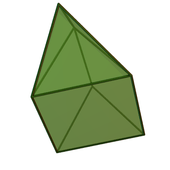Elongated triangular pyramid
| Elongated triangular pyramid | |
|---|---|
 | |
| Type |
Johnson J6 - J7 - J8 |
| Faces |
1+3 triangles 3 squares |
| Edges | 12 |
| Vertices | 7 |
| Vertex configuration |
1(33) 3(3.42) 3(32.42) |
| Symmetry group | C3v, [3], (*33) |
| Rotation group | C3, [3]+, (33) |
| Dual polyhedron | self |
| Properties | convex |
| Net | |
 | |
In geometry, the elongated triangular pyramid is one of the Johnson solids (J7). Norman Johnson discovered elongated triangular pyramids.[citation needed] As the name suggests, it can be constructed by elongating a tetrahedron by attaching a triangular prism to its base. Like any elongated pyramid, the resulting solid is topologically (but not geometrically) self-dual.
A Johnson solid is one of 92 strictly convex regular-faced polyhedra, but which is not uniform, i.e., not a Platonic solid, Archimedean solid, prism or antiprism. They are named by Norman Johnson who first enumerated the set in 1966.
Formulae
The following formulae for volume and surface area can be used if all faces are regular, with edge length a:[1]


If the edges are not the same length, use the individual formulae for the tetrahedron and triangular prism separately, and add the results together.
Dual polyhedron
The dual of the elongated triangular pyramid has 7 faces: 4 triangular, and 3 trapezoidal.
| Dual elongated triangular pyramid | Net of dual |
|---|---|
 |
 |
References
- ↑ Stephen Wolfram, "Elongated triangular pyramid" from Wolfram Alpha. Retrieved July 21, 2010.
External links
- Weisstein, Eric W., "Elongated triangular pyramid", MathWorld.
- Weisstein, Eric W., "Johnson solid", MathWorld.